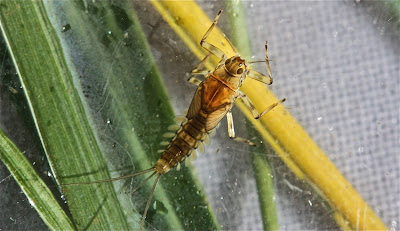I returned to South River today (Greene County) to look for small minnow mayflies, hoping to verify that the small minnow nymph that I found there on January the 5th was indeed Baetis tricaudatus, not Baetis pluto (as I incorrectly stated in the blog that I posted that day). And it was Baetis tricaudatus. I found 5-6 of them today and selected two -- one mature (the one in the photo above), and one not quite mature -- for some photos.
Baetis tricaudatus, I've now learned by reading Knopp and Cormier (Mayflies, pp.44-49), provides the first hatch of "Blue-winged Olives" (terrestrial small minnow mayflies) that we have in the East. The hatch normally starts in March, but there can be multiple broods with a second hatch in May and June and a third in August and September (Knopp and Cormier, p. 46). It's a "mountain" species, and with a tolerance value of 1.5, it will probably only be seen in very clean streams. I've found it in South River (in the Blue Ridge) and in the Rapidan River at the boundary of Shenandoah National Park (see the entries from 2/19 and 1/18 -- where I mistakenly ID'd a mature B. tricaudatus nymph as a B. pluto). And, my good friend who lives in Sugar Hollow has found one in a pristine stream that spills down her hillside emptying into the Moormans. (In the Moormans itself, on the other hand, the small minnows she's finding are Heterocloeon amplum: tolerance value, 3.4)
Let's review the key features we look for on B. tricaudatus nymphs.
B. tricaudatus -- nymphs 5-8 mm; distinct palpal "thumb"; antennal scape and pedicel with robust setae; gill margins without large robust setae and serrate; caudal filament shading gradual, less dark than in B. intercalaris; middle caudal filament less than half as long as lateral filaments. Primarily a Mountain species. (Beaty, "The Ephemeroptera of North Carolina," p. 6.)
1. The two nymphs in the photos above were 8mm long.
2. The "palpal thumbs" are indeed very distinct. (For a good illustration of the labial palps of B. tricaudatus nymphs, see George F. Edmunds, Jr., Steven L. Jensen, and Lewis Berner, The Mayflies of North and Central America [Minneapolis: University of Minnesota Press, 1976, p. 65].)
3. There is robust setae on the antennal scapes and pedicels. But I could not get it to show up clearly even in a microscope photo.
4. The gill margins are indeed serrate and lacking robust setae.
5. The gradual shading of the caudal filaments is, I think, clear in the live photos above; so too is the fact that the middle filament is less than half as long as those on the sides.
6. I might add one other thing that is implied by Beaty in his description of B. brunneicolor. That is, that there should be setae on the paraproct of B. tricaudatus nymphs, a feature that distinguishes B. tricaudatus from B. brunneicolor. The setae on B. tricaudatus is clear from this photo. (Click on the photo to enlarge.)
One more bit of proof -- though I don't think more is needed. Knopp and Cormier (Mayflies, p. 49) describe the body color (dorsal) of B. tricaudatus nymphs in the following way: "grayish olive thorax and olive brown abdomen with abdominal segments 5, 9, 10 paler: rounded 7th gill." Have a look at this picture and key in on segments 5, 9, and 10. Clearly paler than all of the rest.
Well, exciting! We can safely add B. tricaudatus to the list of Baetis nymphs that we have in our streams, joining B. flavistriga, B. intercalaris, and B. pluto. We just have to "go to the mountains" to find it.
______________
Getting good photos of B. tricaudatus nymphs was the main focus of my stream work today. Of course, there were other things to see. As with most of our streams at the moment, South River was loaded with Epeorus pleuralis flatheaded nymphs (on the bottoms of rocks), Isoperla nr. namata Perlodid stoneflies, and Uenoid case-maker caddisfly larvae (look for their cases on the tops of the rocks.)
1. Epeorus pleuralis -- and note that the one is already mature (black wing pads).
2. A couple of Isoperla nr. namata nymphs.
3. And a Uenoid caddisfly larva.
4. Oh. And I also saw -- as I'm seeing elsewhere -- quite a few spiny crawlers.
_______________
(Below: B. tricaudatus nymph found at the Rapidan River on 1/18. Incorrectly ID'd as B. pluto.)





























































